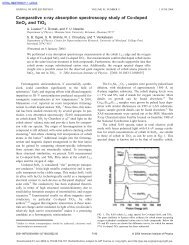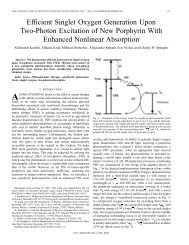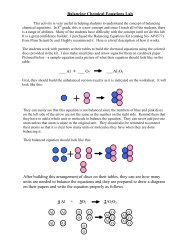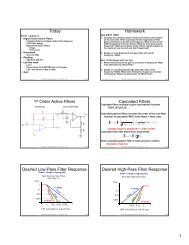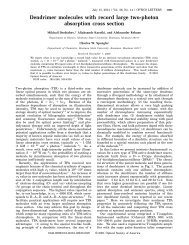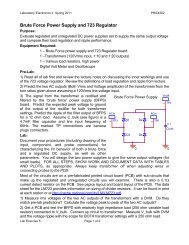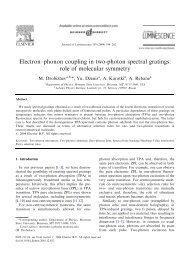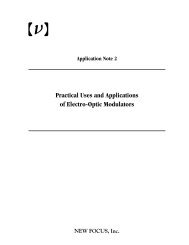Defects in inorganic photorefractive materials and their investigations
Defects in inorganic photorefractive materials and their investigations
Defects in inorganic photorefractive materials and their investigations
Create successful ePaper yourself
Turn your PDF publications into a flip-book with our unique Google optimized e-Paper software.
18 B. Briat et al.<br />
[99, 100]. EPR/optical <strong>in</strong>vestigations on this system [21, 101] showed that a<br />
ma<strong>in</strong> part among the occurr<strong>in</strong>g photo-<strong>in</strong>duced charge transfers <strong>in</strong>volves the<br />
three defects Rh 3+ ,Rh 4+ <strong>and</strong> Rh 5+ , fulfill<strong>in</strong>g the ’3-valence model’ (Fig. 1)<br />
[102]. On this basis <strong>and</strong> rely<strong>in</strong>g on experimentally determ<strong>in</strong>ed values of the<br />
effective trap density N eff , Huot et al. [103], <strong>and</strong> Corner et al. [104] analyzed<br />
the charge transfer properties of the system quantitatively. However, because<br />
the available experimental <strong>in</strong>formation was not sufficient to determ<strong>in</strong>e all relevant<br />
parameters, a simplified theoretical basis was employed. Later, us<strong>in</strong>g<br />
the EPR/optical method, a complete solution of the problem was possible<br />
[105, 106].<br />
The procedure starts with <strong>in</strong>vestigat<strong>in</strong>g the wavelength dependence of the<br />
photochromic coloration of a BT:Rh crystal [98], <strong>in</strong>duced by a series of ris<strong>in</strong>g<br />
pump light energies. The result is plotted over the field of the pump light,<br />
E pump , <strong>and</strong> probe light, E probe , energies (Fig. 9c). Here <strong>and</strong> <strong>in</strong> the follow<strong>in</strong>g<br />
only a rather brief sketch of the method is given. For further details see Refs.<br />
[105, 106]. The ma<strong>in</strong> features <strong>in</strong> Fig. 9c are a strong light <strong>in</strong>duced transparency<br />
at E probe =1.9 eV <strong>and</strong> pronounced absorption <strong>in</strong>creases at 1.6 eV <strong>and</strong> 3.0 eV.<br />
Simultaneous measurements of the EPR of Rh 4+ , the only EPR-active Rh<br />
charge state <strong>in</strong> ’as grown’ BT:Rh - observable at T ≤ 20 K, show that the<br />
<strong>in</strong>tensity of this EPR signal has an identical dependence on E pump as that of<br />
the transparency along E probe =1.9 eV. This assigns the b<strong>and</strong> at 1.9 eV to<br />
Rh 4+ . Further EPR studies [107] <strong>in</strong>dicate that the Rh 4+ <strong>in</strong>tensity is decreased<br />
by the transfer of a valence b<strong>and</strong> electron to Rh 4+ . In this way the EPR-silent<br />
charge state Rh 3+ is created. The b<strong>and</strong> at 3.0 eV is attributed to Rh 3+ ,ly<strong>in</strong>g<br />
higher than Rh 4+ because of its lower charge. The hole created <strong>in</strong> the valence<br />
b<strong>and</strong> by the electron transfer to Rh 4+ is expected to be captured by another<br />
Rh 4+ ,caus<strong>in</strong>gRh 5+ , which is also EPR-silent. Because of its higher charge,<br />
less energy is needed to excite a valence b<strong>and</strong> electron to Rh 5+ . Therefore the<br />
other strong feature <strong>in</strong> Fig. 9c, at 1.6 eV, is assigned to Rh 5+ . In a similar way<br />
the further structures <strong>in</strong> Fig. 9c are attributed to various charge states of Fe;<br />
this element is usually present <strong>in</strong> BT as an un<strong>in</strong>tended background impurity.<br />
These assignments fulfill systematic topological constra<strong>in</strong>ts typical for plots<br />
of the type of Fig. 9c [108].<br />
Summariz<strong>in</strong>g this part: By comb<strong>in</strong>ed EPR/optical absorption studies,<br />
based on the photochromic behavior of BT, the optical absorption b<strong>and</strong>s <strong>in</strong>dicated<br />
by vertical dashed l<strong>in</strong>es <strong>in</strong> Fig. 9c, have been identified. Among these<br />
only the defects Rh 4+ ,Fe 5+ <strong>and</strong> Fe 3+ are EPR-active. The position of the<br />
Fe 3+ b<strong>and</strong>, covered by the fundamental absorption, has been <strong>in</strong>ferred from<br />
its peak energy <strong>in</strong> KTaO 3 , Fig. 10. The other optical b<strong>and</strong>s, belong<strong>in</strong>g to the<br />
EPR-silent defects Rh 3+ ,Rh 5+ <strong>and</strong> Fe 4+ , are assigned by consistency arguments<br />
of the type as forwarded for Rh 3+ <strong>and</strong> Rh 5+ . This identification of the<br />
optical absorption b<strong>and</strong>s allows that they can be used as ’f<strong>in</strong>gerpr<strong>in</strong>ts’ of the<br />
correspond<strong>in</strong>g defects. They can be employed likewise at room temperature;<br />
EPR-measurements, on the other h<strong>and</strong>, usually require low temperatures. As<br />
shown, also absorption b<strong>and</strong>s correspond<strong>in</strong>g to EPR-silent defects could be





